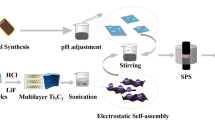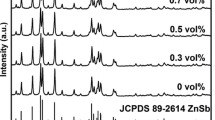Abstract
SiGe-based thermoelectric (TE) materials have gained increasing interests due to their low maintenance costs, environmental friendliness and long lifespan. However, the intrinsically high thermal conductivity of Si-based materials also results in poor TE properties. In this investigation, a zirconia (ZrO2) composite strategy was applied to an n-type SiGe alloy, tremendously elevating its TE performance. After mechanical alloying and spark plasma sintering (SPS) processes, the ZrO2 induced the formation of nanopores in the SiGe matrix via phosphorus adsorption. Moreover, such increase in porosity enhanced the phonon scattering and dramatically suppressed lattice thermal conductivity, from 2.83 to 1.59 W·m−1·K−1 at 873 K. Additionally, reduced phosphorus doping led to an increase in Seebeck coefficients and a relatively minor decrease in electrical conductivity. The power factor didn’t deteriorate significantly, either, as its maximum of ~ 3.43 mW·m−1·K−2 was achieved at 873 K with (Si0.8Ge0.2)0.097P0.03(ZrO2)0.003. In short, a peak figure of merit (ZT) of ~ 1.27 at 873 K and an average ZT ~ 0.7 from 323 to 873 K were obtained. This study demonstrates that the electrical and thermal transportation of SiGe material can be synergistically tuned by compositing ZrO2, illustrating a novel strategy to optimize the TE properties of bulk materials.
Graphical abstract

摘要
硅锗基热电 (TE) 材料因其低维护成本, 环保性和长寿命而受到越来越多的关注. 然而, 硅锗基材料固有的高热导率也导致了其糟糕的TE性能. 在本研究中, 一种氧化锆 (ZrO2) 复合策略被应用于n型硅锗合金中, 极大地提升了其TE性能. 经过机械合金化和火花等离子烧结 (SPS) 过程后, ZrO2 通过磷吸附诱导了硅锗基体中纳米孔的形成. 此外, 这种孔隙率的出现增强了声子散射, 极大地抑制了晶格热导率, 从873 K的 2.83 W m−1·K−1 降至 1.59 W·m−1·K−1. 此外, 磷掺杂的减少导致s赛贝克系数的增加和电导率的小幅下降. 功率因子没有显著恶化, 873 K时(Si0.8Ge0.2)0.97P0.03(ZrO2)0.003其最大功率因子为 3.43 mW·m−1·K−2. 总之, 我们制备的氧化锆复合硅锗热电材料在873 K的峰值ZT为 1.27, 从 323 到 873 K的平均ZT为 0.7. 本研究表明, 通过复合 ZrO2, 硅锗材料的电s输运和热传导可以协同调控, 这展示了一种优化块材料r热电性能的新颖策略.







Similar content being viewed by others
References
Meng K, Zhao LM, Zhang NY, Zhang ZF, Shen WX, Zhang YW, Wan B, Fang C, Chen LC, Wang QQ, He JL, Jia XP. Thermoelectric properties of n-type SiGe alloys with Sn incorporation. Rare Met. 2022;41(12):3957. https://doi.org/10.1007/s12598-022-02085-z.
Yu ZH, Wang XT, Liu CY, Cheng YR, Zhang ZW, Si RF, Bai XB, Hu XK, Gao J, Peng Y, Miao L. Carrier and microstructure tuning for improving the thermoelectric properties of Ag8SnSe6 via introducing SnBr 2. J Adv Ceram. 2022;11(7):1144. https://doi.org/10.1007/s40145-022-0601-7.
Li XY, Song GH, Li GP, Liu Y, Hu F. Advances in Mg3X2(X=Sb, Bi)-based thermoelectric materials. Chin J Rare Met. 2022,46(12):1621. https://doi.org/10.13373/j.cnki.cjrm.XY20090032.
Zhuang HL, Hu H, Pei J, Su B, Li JW, Jiang Y, Han Z, Li JF. High ZT in p-type thermoelectric (Bi, Sb)2Te3 with built-in nanopores. Energ Environ Sci. 2022;15(5):2039. https://doi.org/10.1039/d2ee00119e.
Tang S, Wu M, Bai S, Luo D, Zhang J, Yang S. Honeycomb-like puckered PbTe monolayer: a promising n-type thermoelectric material with ultralow lattice thermal conductivity. J Alloy Compd. 2022;907:164439. https://doi.org/10.1016/j.jallcom.2022.164439.
Liang JS, Shi XL, Peng Y, Liu WD, Yang HQ, Liu CY, Chen JL, Zhou Q, Miao L, Chen ZG. Synergistic effect of band and nanostructure engineering on the boosted thermoelectric performance of n-Type Mg3+δ(Sb, Bi)2 Zintls. Adv Energy Mater. 2022;12(26):2201086. https://doi.org/10.1002/aenm.202201086.
Parasuraman R, Wu Y, Ordonez-Miranda J, Volz S, Umarji AM. Particle size effect on the thermal conductivity reduction of silicon based thermoelectric composites. Sustain Energy Fuels. 2018;2(8):1764. https://doi.org/10.1039/c8se00131f.
Liu HX, Zhang XY, Bu ZL, Li W, Pei YZ. Thermoelectric properties of (GeTe)1–x[(Ag2Te)0.4(Sb2Te3)0.6]x alloys. Rare Met. 2021;41(3):921. https://doi.org/10.1007/s12598-021-0847-5.
Garg J, Bonini N, Kozinsky B, Marzari N. Role of disorder and anharmonicity in the thermal conductivity of silicon-germanium alloys: a first-principles study. Phys Rev Lett. 2011;106(4):045901. https://doi.org/10.1103/PhysRevLett.106.045901.
Mingo N, Hauser D, Kobayashi NP, Plissonnier M, Shakouri A. “Nanoparticle-in-alloy” approach to efficient thermoelectrics: silicides in SiGe. Nano Lett. 2009;9(2):711. https://doi.org/10.1021/nl8031982.
Perez Taborda JA, Munoz Rojo M, Maiz J, Neophytou N, Martin Gonzalez M. Ultra-low thermal conductivities in large-area Si-Ge nanomeshes for thermoelectric applications. Sci Rep. 2016;6:32778. https://doi.org/10.1038/srep32778.
Hosseini SA, Romano G, Greaney PA. Mitigating the effect of nanoscale porosity on thermoelectric power factor of Si. ACS Appl Energ Mater. 2021;4(2):1915. https://doi.org/10.1021/acsaem.0c02640.
Hao Q, Xiao Y, Zhao H. Analytical model for phonon transport analysis of periodic bulk nanoporous structures. Appl Therm Eng. 2017;111:1409. https://doi.org/10.1016/j.applthermaleng.2016.06.075.
Zhang X, Ying C, Li Z, Shi G. First-principles calculations of structural stability, elastic, dynamical and thermodynamic properties of SiGe, SiSn, GeSn. Superlattices and Micro. 2012;52(3):459. https://doi.org/10.1016/j.spmi.2012.06.001.
Guo CR, Qin BC, Wang DY, Zhao LD. Investigation on halogen-doped n-type SnTe thermoelectrics. Rare Met. 2022;41(11):3803. https://doi.org/10.1007/s12598-022-02076-0.
Nong J, Peng Y, Liu CY, Shen JB, Liao Q, Chiew YL, Oshima Y, Li FC, Zhang ZW, Miao L. Ultra-low thermal conductivity in B2O3 composited SiGe bulk with enhanced thermoelectric performance at medium temperature region. J Mater Chem A. 2022;10(8):4120. https://doi.org/10.1039/d1ta09198k.
Wang J, Li JB, Yu HY, Li J, Yang H, Yaer X, Wang XH, Liu HM. Enhanced thermoelectric performance in n-type SrTiO3/SiGe composite. ACS Appl Mater Interfaces. 2020;12(2):2867. https://doi.org/10.1021/acsami.9b20090.
Liu D, Dreβler C, Seyring M, Teichert S, Rettenmayr M. Reduced thermal conductivity of Bi-In-Te thermoelectric alloys in a eutectic lamellar structure. J Alloy Compd. 2018;748:730. https://doi.org/10.1016/j.jallcom.2018.03.201.
Chiritescu C, Cahill DG, Heideman C, Lin Q, Mortensen C, Nguyen NT, Johnson D, Rostek R, Böttner H. Low thermal conductivity in nanoscale layered materials synthesized by the method of modulated elemental reactants. J Appl Phys. 2008;104(3):033533. https://doi.org/10.1063/1.2967722.
Zheng Y, Liu C, Miao L, Li C, Huang R, Gao J, Wang X, Chen J, Zhou Y, Nishibori E. Extraordinary thermoelectric performance in MgAgSb alloy with ultralow thermal conductivity. Nano Energ. 2019;59:311. https://doi.org/10.1016/j.nanoen.2019.02.045.
Kojda D, Hofmann T, Gostkowska Lekner N, Habicht K. Characterization and modeling of the temperature-dependent thermal conductivity in sintered porous silicon-aluminum nanomaterials. Nano Res. 2022;15(6):5663. https://doi.org/10.1007/s12274-022-4123-y.
Jalili S, Keshavarz M. Zirconia (1 1 0) surface adsorption behavior – A density functional theory study. Comput Theor Chem. 2020;1173:112702. https://doi.org/10.1016/j.comptc.2020.112702.
Lin J, He S, Wang X, Zhang H, Zhan Y. Removal of phosphate from aqueous solution by a novel Mg(OH)2/ZrO2 composite: adsorption behavior and mechanism. Colloid Surface A. 2019;561:301. https://doi.org/10.1016/j.colsurfa.2018.11.001.
Romo-De-La-Cruz CO, Chen Y, Liang L, Williams M, Song X. Thermoelectric oxide ceramics outperforming single crystals enabled by dopant segregations. Chem Mater. 2020;32(22):9730. https://doi.org/10.1021/acs.chemmater.0c03437.
Huang C, Zhao X, Regner K, Yang R. Thermal conductivity model for nanoporous thin films. Physica E. 2018;97:277. https://doi.org/10.1016/j.physe.2017.11.014.
Cao L, Pan J, Zhang H, Zhang Y, Wu Y, Lv YY, Yan XJ, Zhou J, Chen YB, Yao SH, Pei Y, Lu MH, Chen YF. One-order decreased lattice thermal conductivity of snse crystals by the introduction of nanometer SnSe2 secondary phase. J Phys Chem C. 2019;123(45):27666. https://doi.org/10.1021/acs.jpcc.9b08700.
Chen XQ, Fan SJ, Han C, Wu T, Wang LJ, Jiang W, Dai W, Yang JP. Multiscale architectures boosting thermoelectric performance of copper sulfide compound. Rare Met. 2021;40(8):2017. https://doi.org/10.1007/s12598-020-01698-6.
Yang R, Chen G. Thermal conductivity modeling of periodic two-dimensional nanocomposites. Phys Rev B. 2004;69(19):195316. https://doi.org/10.1103/PhysRevB.69.195316.
Deng ZY, Ferreira JMF, Tanaka Y, Isoda Y. Microstructure and thermal conductivity of porous ZrO2 ceramics. Acta Mater. 2007;55(11):3663. https://doi.org/10.1016/j.actamat.2007.02.014.
Liu H, Zhao X. Thermal conductivity analysis of high porosity structures with open and closed pores. Int J Heat Mass Tran. 2022;183:122089.
Tian BZ, Jiang XP, Chen J, Gao H, Wang ZG, Tang J, Zhou DL, Yang L, Chen ZG. Low lattice thermal conductivity and enhanced thermoelectric performance of SnTe via chemical electroless plating of Ag. Rare Met. 2022;41(1):86. https://doi.org/10.1007/s12598-021-01805-1.
Wang Y, Liu WD, Gao H, Wang LJ, Li M, Shi XL, Hong M, Wang H, Zou J, Chen ZG. High porosity in nanostructured n-type Bi2Te3 obtaining ultralow lattice thermal conductivity. ACS Appl Mater Inter. 2019;11(34):31237. https://doi.org/10.1021/acsami.9b12079.
Ahmad S, Basu R, Sarkar P, Singh A, Bohra A, Bhattacharya S, Bhatt R, Meshram KN, Samanta S, Bhatt P, Navaneethan M, Hayakawa Y, Debnath AK, Gupta SK, Aswal DK, Muthe KP, Gadkari SC. Enhanced thermoelectric figure-of-merit of p-type SiGe through TiO2 nanoinclusions and modulation doping of boron. Materialia. 2018;4:147. https://doi.org/10.1016/j.mtla.2018.09.029.
Zhou B, Chen L, Li C, Qi N, Chen Z, Su X, Tang X. Significant enhancement in the thermoelectric performance of aluminum-doped ZnO tuned by pore structure. ACS Appl Mater Interfaces. 2020;12(46):51669. https://doi.org/10.1021/acsami.0c16506.
Kennedy N, Duffy R, Mirabelli G, Eaton L, Petkov N, Holmes JD, Hatem C, Walsh L, Long B. Monolayer doping of silicon-germanium alloys: a balancing act between phosphorus incorporation and strain relaxation. J Appl Phys. 2019;126(2):025103. https://doi.org/10.1063/1.5086356.
Bera C, Mingo N, Volz S. Marked effects of alloying on the thermal conductivity of nanoporous materials. Phys Rev Lett. 2010;104(11):115502. https://doi.org/10.1103/PhysRevLett.104.115502.
Smith JB, Ehrenreich H. Frequency dependence of the optical relaxation time in metals. Phys Rev B. 1982;25(2):923. https://doi.org/10.1103/PhysRevB.25.923.
Xiao Y, Zhang X, Zhang J. [Ca24Al28O64]4+(4e−) electrides ceramic with high-electron concentration rapidly fabricated by spark plasma sintering of Ca, Al organic powder precursor in spark plasma sintering. Ceram Int. 2020;46(17):27742. https://doi.org/10.1016/j.ceramint.2020.07.273.
Shi XL, Zou J, Chen ZG. Advanced thermoelectric design: from materials and structures to devices. Chem Rev. 2020;120(15):7399. https://doi.org/10.1021/acs.chemrev.0c00026.
Ahmad S, Singh A, Bohra A, Basu R, Bhattacharya S, Bhatt R, Meshram KN, Roy M, Sarkar SK, Hayakawa Y, Debnath AK, Aswal DK, Gupta SK. Boosting thermoelectric performance of p-type SiGe alloys through in-situ metallic YSi2 nanoinclusions. Nano Energ. 2016;27:282. https://doi.org/10.1016/j.nanoen.2016.07.002.
Qi X, Huang Y, Wu D, Jiang B, Zhu B, Xu X, Feng J, Jia B, Shu Z, He J. Eutectoid nano-precipitates inducing remarkably enhanced thermoelectric performance in (Sn1−xCdxTe)1−y(Cu2Te)y. J Mater Chem A. 2020;
Basu R, Bhattacharya S, Bhatt R, Roy M, Ahmad S, Singh A, Navaneethan M, Hayakawa Y, Aswal DK, Gupta SK. Improved thermoelectric performance of hot pressed nanostructured n-type SiGe bulk alloys. J Mater Chem A. 2014;2(19):6922. https://doi.org/10.1039/c3ta14259k.
Zhai RS, Zhu TJ. Improved thermoelectric properties of zone-melted p-type bismuth-telluride-based alloys for power generation. Rare Met.2022;41. https://doi.org/10.1007/s12598-022-01985-4.
Wang XW, Lee H, Lan YC, Zhu GH, Joshi G, Wang DZ, Yang J, Muto AJ, Tang MY, Klatsky J, Song S, Dresselhaus MS, Chen G, Ren ZF. Enhanced thermoelectric figure of merit in nanostructured n-type silicon germanium bulk alloy. Appl Phys Lett. 2008;93(19):193121. https://doi.org/10.1063/1.3027060.
Nozariasbmarz A, Zamanipour Z, Norouzzadeh P, Krasinski JS, Vashaee D. Enhanced thermoelectric performance in a metal/semiconductor nanocomposite of iron silicide/silicon germanium. Rsc Adv. 2016;6(55):49643. https://doi.org/10.1039/c6ra01947a.
Acknowledgements
This work was financially supported by the National Key Research and Development Program of China (Nos. 2022YFE0119100 and 2017YFE0198000), the National Natural Science Foundation of China (Nos. U21A2054, 52273285, 52061009 and 52262032) and Guangxi Science and Technology Planning Project (No. AD21220056).
Author information
Authors and Affiliations
Corresponding authors
Ethics declarations
Conflict of interests
The authors declare that they have no conflict of interest.
Supplementary Information
Below is the link to the electronic supplementary material.
Rights and permissions
Springer Nature or its licensor (e.g. a society or other partner) holds exclusive rights to this article under a publishing agreement with the author(s) or other rightsholder(s); author self-archiving of the accepted manuscript version of this article is solely governed by the terms of such publishing agreement and applicable law.
About this article
Cite this article
Wang, MF., Lai, HJ., Liang, JS. et al. Enhanced thermoelectric performance enabled by compositing ZrO2 in n-type SiGe alloy with low thermal conductivity. Rare Met. 43, 1167–1176 (2024). https://doi.org/10.1007/s12598-023-02469-9
Received:
Revised:
Accepted:
Published:
Issue Date:
DOI: https://doi.org/10.1007/s12598-023-02469-9




